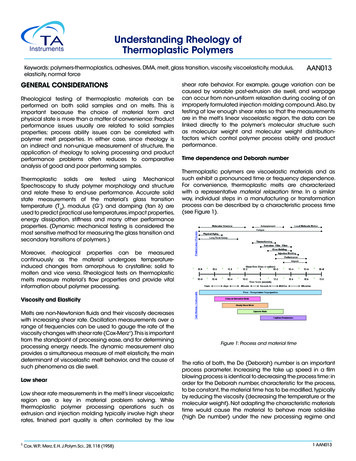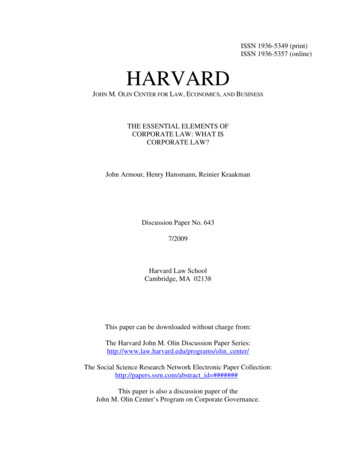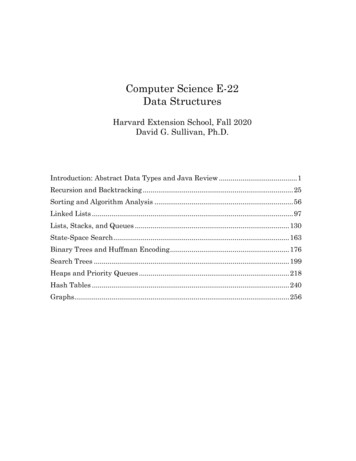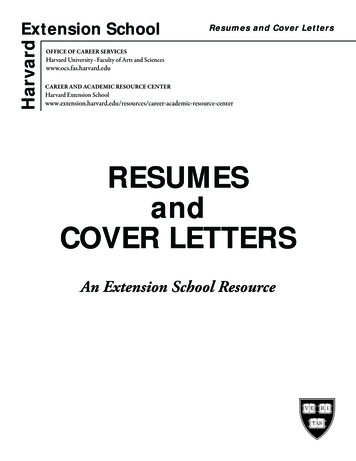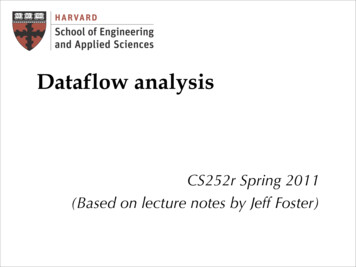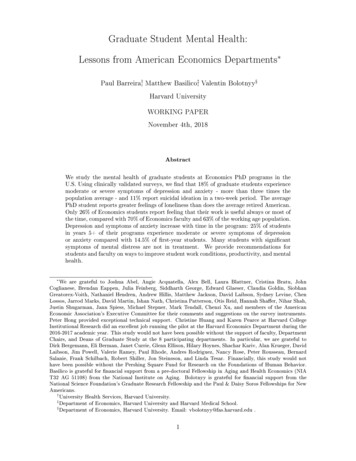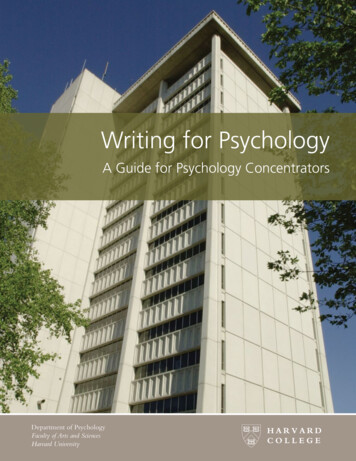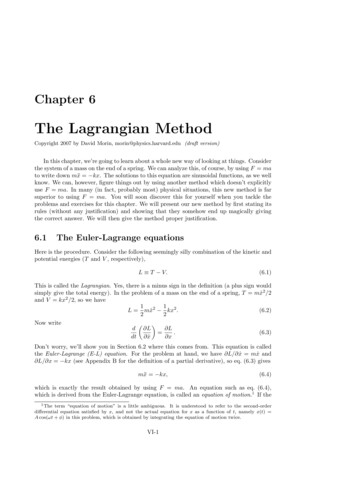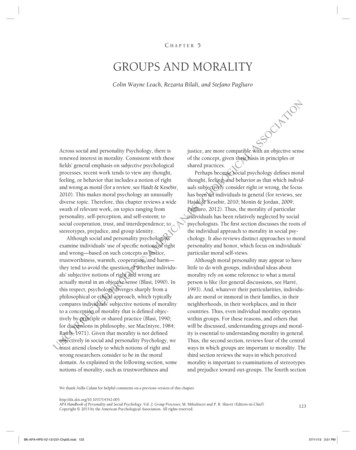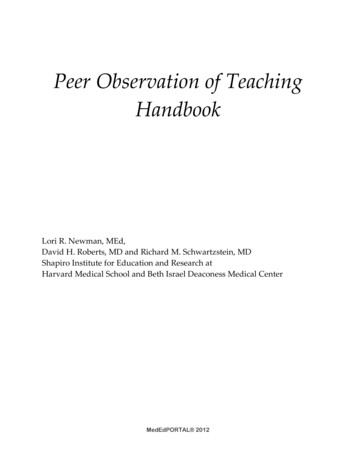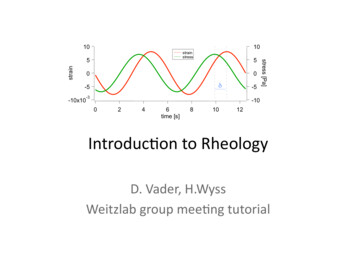
Transcription
1010strainstressstrain500δ-5-10x10-5-3stress [Pa]5-100246time [s]81012Introduc)on to RheologyD. Vader, H.WyssWeitzlab group mee)ng tutorial
What is rheology? Rheology is the study of the flow of maBer: mainlyliquids but also soE solids or solids under condi)ons inwhich they flow rather than deform elas)cally. Itapplies to substances which have a complex structure,including muds, sludges, suspensions, polymers, manyfoods, bodily fluids, and other biological materials.EmulsionsCheeseBiopolymersFoams
What is rheology? The term rheology was coined in 1920s, andwas inspired by a Greek quota)on, "panta rei","everything flows". In prac)ce, rheology is principally concernedwith extending the "classical" disciplines ofelas)city and (Newtonian) fluid mechanics tomaterials whose mechanical behavior cannotbe described with the classical theories.
Basic conceptsLL ΔLarea AFFarea AFhFΔx
Simple mechanical elementsElastic solid: force (stress) proportional to strainViscous fluid: force (stress) proportional to strain rateViscoelastic material: time scales are importantFast deformation: solid-likeSlow deformation: fluid-like
Response to deforma)onStep strainstresstimestresstimestresstimetime
Oscillatory ess [Pa]5-1002Elastic solid:Viscous fluid:Viscoelastic material, use:46time [s]81012Stress and strain are in phaseStress and strain are out of phase
Lissajou plotsstrainstressstrain00δ-5-5-3-100246time [s]810125-5-10-355500-5-5-3-100246time [s]81012stress [Pa]10stress [Pa]10-10x10G'0-10x10 -5strain ratestress10strain rate [1/s]105stress [Pa]5-10x10Lissajou10stress [Pa]100strain510G''/ω0-5-10-3-10x10 -505strain rate [1/s]10
Strain‐control vs lledBohlin, AR-G2, Anton Paar
Strain‐control vs stress‐control Strain‐controlled state typically consideredbe2er defined Stress‐controlled rheometers have beBertorque sensi)vity Strain‐controlled rheometers can probe higherfrequencies BUT nowadays, feedback loops are fastenough that most rheometers can operate OKin both modes
Rheometer geometries Cone-plate uniform strain / strain-rate fixed gap height Plate-plate non-uniform strain adjustable gap height good for testing boundary effects like slip Couette cell good sensitivity for low-viscosity fluids
Linear viscoelas)cityAcquire data at constant frequency, increasing stress/strainstorage modulus G’loss modulus G”strain amplitude γ0
Typical protocol Limits of linear viscoelas)c regime in desiredfrequency range using amplitude sweeps yield stress/strain, cri)cal stress/strain Test for )me stability, i.e )me sweep at constainamplitude and frequency Frequency sweep at various strain/stressamplitudes within linear regime Study non‐linear regime
Nonlinear rheology (of biopolymers) “Unlike simple polymer gels, many biological materials—including blood vessels, mesentery ssue, lung parenchyma,cornea and blood clots—s ffen as they are strained, therebypreven ng large deforma ons that could threaten ssueintegrity.” (Storm et al., 2005)stiffeningweakening
Oscillatory strain sweeps (collagen gels)
Lissajou plots from the G2 Raw data toolLissajou plot, 1% strain
Nonlinear Lissajou plot4stress [Pa]20-2-4-40x10-3-200strain2040
Nonlinear Lissajou plot4RAW DATAσ' (elastic stress)fit to σ'stress [Pa]20-2-4-40x10-3-200strain2040
2.4mg/mL cone‐plate
2.4mg/mL cone‐plate
MIT LAOS MATLAB package
Creep‐ringing
Creep‐ringing Norman & Ryan’s work here (fibrin, jamming) Good tutorial by Ewoldt & McKinley (MIT)
Creep‐ringing resultsI: bulk proper)es
More nonlinear rheology Stress/strain ramps with constant rate Pre‐stress measurements, i.e. small stressoscilla)ons around a constant (pre‐)stress Pre‐strain measurements Transient responses in LAOS (talk to Stefan) Fourier domain analysis SRFS (talk to Hans)Linear behavior
Origin of nonlinear behavior Distribu)on of length‐scales / inhomogenei)es Rearrangement of par)cles / filaments Non‐affine mo)on How do we find out?Observation at the microscopic scale: Microrheology Microscopy
Microrheology basics General idea: look at the thermally‐drivenmo)on of micron‐sized par)cles embedded in amaterial Mean‐square displacement of par)cles as afunc)on of )me provides microscopicinforma)on on local elas)c and viscous materialproper)es as a func)on of frequency Mason and Weitz, PRL, 1995
Short and long )mescalesShort time scales:diffusiver: position vectorD: diffusion constantτ: lag timekT: thermal energya: particle sizeη: viscosityLong time scales:spring-likeK: effective springconstant, linked toelastic propertiesWhat about intermediate times?
Generalized Stokes‐EinsteinTake Laplace transform of η(τ) numerically, to get η(s) – with s iω.From earlier, we know:We can then get the generalized complex modulus, by analytically extending:i.e.
2‐point vs 1‐point microrheology2-point microrheology calculates amean-square displacement fromthe correlated pair-wise motion ofparticles, rather than the singleparticle MSD.Black: bulk rheologyRed: 2-point microrheologyBlue: 1-point microrheologyOpen symbols: G”
Other considera)ons Non‐linear regime non‐trivial, but moreinteres)ng. Surface effects can be important. Imaging to figure out mechanisms. Richness of effects, mechanisms, )me‐, length‐and energy‐ scales present in soE maBer /complex fluids. More to explore on Weitzlab webpage. More at ComplexFluids mee)ngs.
Rheometer geometries Cone-plate uniform strain / strain-rate fixed gap height Plate-plate non-uniform strain adjustable gap height good for testing boundary effects like slip Couette cell good sensitivity for low-viscosity fluids . Linear viscoelascity strain amplitude γ 0 storage modulus G’ loss modulus G” Acquire data at constant frequency, increasing stress .
